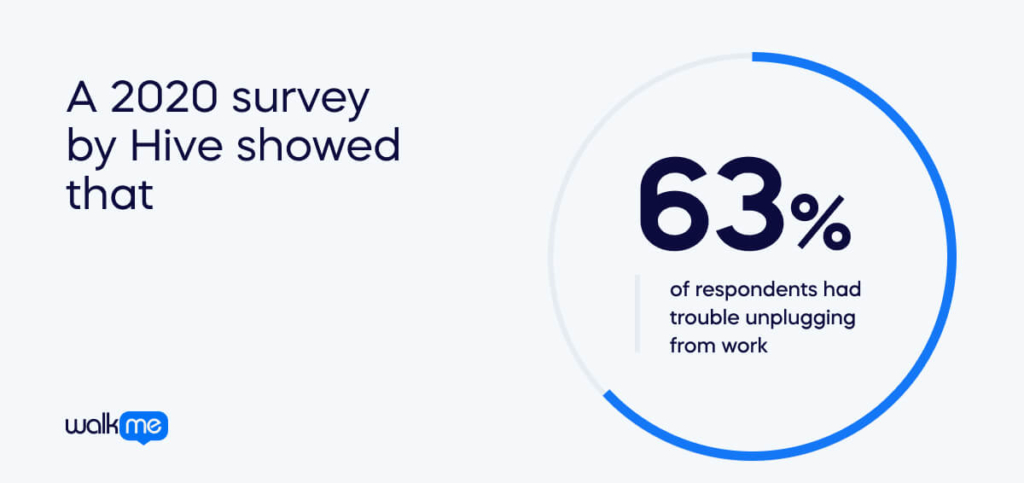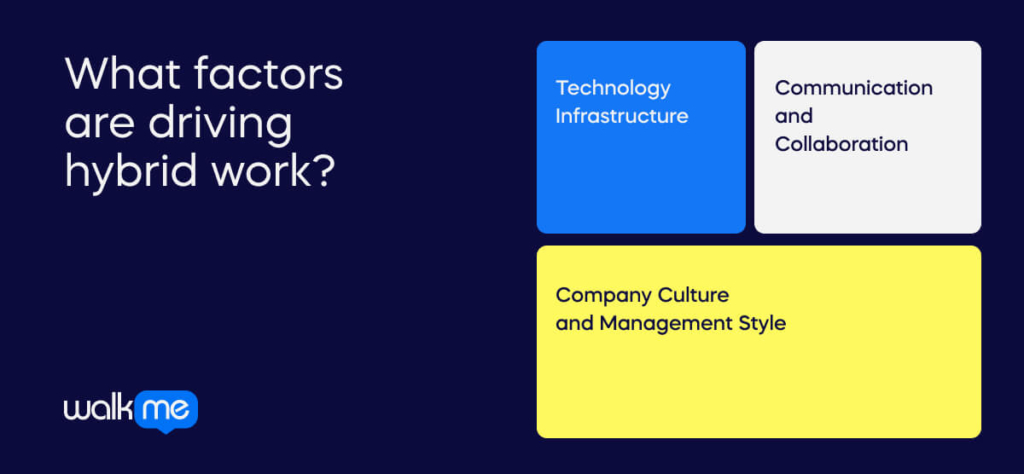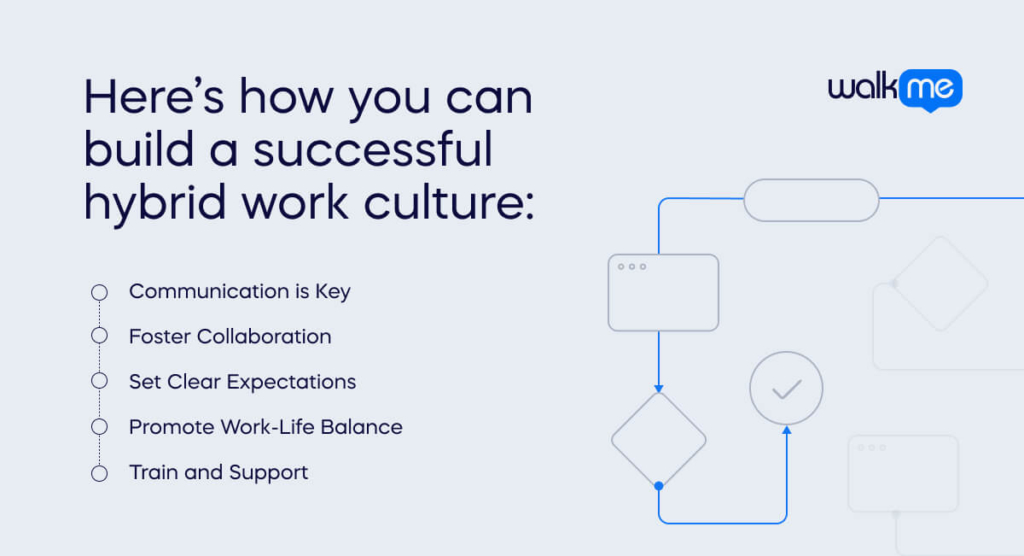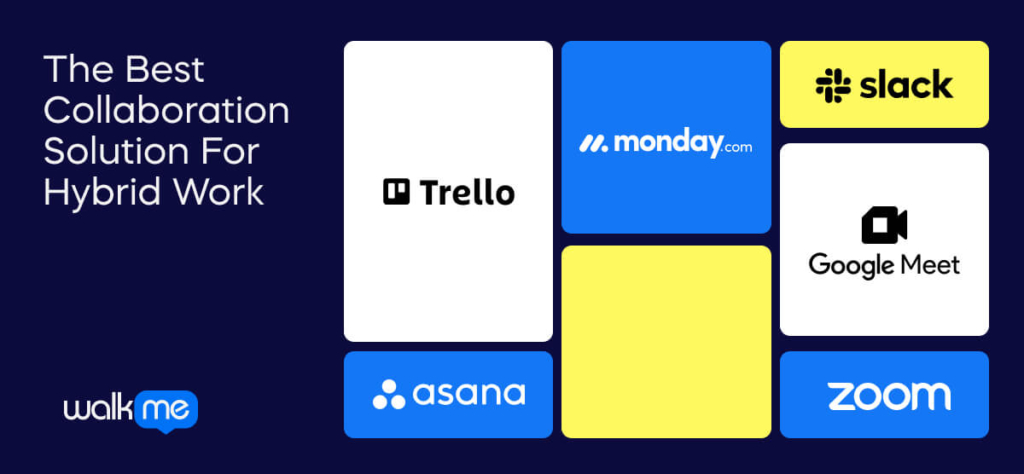Hybrid work is a flexible employment model that combines both in-office and remote working.
In this setup, employees can choose their workspace, dividing their time between working from a corporate office and a location of their choice, which could be their home or any other non-employer location.
This model supports traditional office workers and remote and on-the-go employees, offering a blend of collaboration, socialization, and flexibility. It represents integrating the best aspects of in-person and remote work environments.
Work from home (WFH) has rapidly become a reality for many as more and more businesses explore the possibilities of remote working.
Changing times and the ever-evolving digital world have caused an influx of different ways to approach remote work, including the hybrid work model, which blends both in-office and remote work.
Once you’ve had a taste of remote work, it’s hard to go back. According to Buffer’s 2021 State of Remote Work report, 97.6% of remote workers want to continue working remotely for the rest of their careers.
But what exactly is hybrid working, how does it work, and what are the benefits or drawbacks of adopting such a flexible approach?
In this article, we’ll take a step back to analyze the pros and cons of adopting a hybrid workplace.
By the time you’re done reading, you’ll know everything you need to make informed decisions about successfully navigating your organization into this new era.
What Is Hybrid Work?
Hybrid work is a new approach to work that blends elements of traditional office-based work with remote work.
A hybrid workforce is a flexible work arrangement where employees can work remotely for part of their workweek and come into the office for the remaining time. This approach combines the best of both worlds – the productivity and structure of traditional office-based work with the freedom and autonomy of remote work.
Unlike traditional office-based work, which typically requires employees to be physically present in the office throughout the week, hybrid work offers a better work-life balance. It allows employees to avoid long commutes and enjoy the benefits of increased productivity and reduced stress.
By embracing a hybrid work model, organizations can unlock the potential for greater employee satisfaction and improved performance. It offers the opportunity to leverage technology and create a work environment that empowers employees to thrive, regardless of their physical location.
A hybrid workforce provides the flexibility and freedom needed to adapt to the changing dynamics of the modern workplace while still maintaining the productivity and structure that come with office-based work.
The Benefits of Hybrid Work

The hybrid work model offers a balanced solution between fully remote and traditional in-office work approaches.
Adopting a hybrid work model allows you to merge the best aspects of remote work with the benefits of in-person collaboration and connection. This combination optimally benefits both individuals and organizations, providing an ideal balance.
Benefits Include:
Flexibility
Hybrid work offers a clear advantage: flexibility.
It empowers employees to work from home or any remote location for a portion of their week while allowing them to come into the office on designated days. This arrangement fosters collaboration with colleagues, facilitates meetings, and provides access to office resources that may not be readily available at home.
The beauty of this flexibility lies in its ability to enhance efficiency and effectiveness, all while saving valuable time and commuting expenses.
Better Work-Life Balance
With the added flexibility of hybrid work, employees can better manage their personal lives, allowing them to attend to familial responsibilities or personal interests while still fulfilling their professional commitments.
This work arrangement empowers employees to have more control over their schedules, optimizing their work-life balance and making time for activities that bring them joy and fulfillment outside of work.
This increased autonomy and balance can ultimately lead to greater job satisfaction and employee well-being.
Increased Productivity
Hybrid work allows employees to focus on the most important tasks without distractions and disruptions from office chatter or lengthy commutes.
Hybrid work also allows employees access to resources they might not otherwise have at home, such as specialized equipment or software programs.
As a result, employees can work more efficiently and effectively, increasing employee productivity.
Potential Savings on Real-Estate Expenses
Organizations can save money on real estate expenses by offering hybrid work arrangements, as fewer workers will occupy the same space at any time.
A hybrid office can help reduce overhead costs for businesses and make them more efficient overall.
Drawbacks to Hybrid Work

It’s important to note that while hybrid work offers many potential benefits, it also has drawbacks.
Once again, being a middle-of-the-road solution, hybrid work has its drawbacks, encompassing the disadvantages of both remote and in-office work models.
Drawbacks of hybrid work:
Harder to Collaborate
One potential drawback of implementing a hybrid work model is the challenge of fostering collaboration and coordination when employees are not physically present in the same location.
Building relationships and cultivating a sense of teamwork between remote workers and those based in the office becomes more difficult without face-to-face interaction. To address this issue, it is crucial to establish effective processes and systems that facilitate seamless collaboration between onsite and offsite employees.
Talent Pool Still Limited by Location
Another potential drawback is that the talent pool for a business is still limited by its physical location.
Hybrid work models do expand the size of your location-based talent pool. A potential employee might be turned away from a role at your business because of a commute that’s too long or difficult to do every single day.
But that same employee might believe the commute is manageable two or three days a week— so a hybrid work model draws them back into your talent pool.
That said, the bottom line is that you cannot access talent worldwide as easily as you can with fully remote work models.
Increased Risk of Burnout

Finally, hybrid work can also lead to an increased risk of burnout. A 2020 survey by Hive showed that 63% of respondents had trouble unplugging from work.
Employees who balance remote and in-office work may be stretched too thin or overwhelmed.
As such, you must ensure your business implements policies that promote a healthy work/life balance for your employees.
You must provide resources to support the mental well-being of your employees and help prevent burnout.
What Is A Hybrid Working Model?
A hybrid working model is a flexible work approach that blends various work locations: the office, home, or on the move.
This model allows employees to work remotely while maintaining access to in-office collaboration. It’s a customizable approach that organizations can tailor to meet their unique needs and goals. By promoting a better work-life balance, it has the potential to enhance employee productivity and satisfaction.
A hybrid working model enables businesses to optimize cooperation and creativity by reconfiguring their workspace. There are various types of hybrid models, all blending in-workplace and remote experiences in different ways.
The key to a successful hybrid work model lies in striking the right balance between in-office and remote locations, ensuring that both business needs and employee preferences are met. Implementing a hybrid work model requires careful planning and consideration of its benefits and challenges.
What Are The Types Of Hybrid Working Models?

We’ve identified the following hybrid working models that organizations can implement to allow their employees to work in both physical and virtual office spaces:
The Fully Flexible Model
Under the fully flexible model, employees can choose when and where they work, whether in the office, at home, or elsewhere. The focus here is on output rather than hours worked, providing maximum autonomy and work-life balance.
The Split Week Model
In the split-week model, employees spend a set number of days in the office each week, with the remaining days working remotely. This offers a predictable routine and ensures regular face-to-face collaboration while maintaining flexibility.
The Hub-and-Spoke Model
The hub-and-spoke model involves a central office (the hub) and various remote working locations (the spokes). Employees can work from the hub, a spoke location, or remotely. This model can help businesses maintain a physical presence in multiple locations without requiring all employees to commute to a central office.
The Rotational Model
Under the rotational model, teams or individuals rotate between office-based and remote work. This allows for regular in-person collaboration and can help manage office capacity while still offering periods of remote work.
Different hybrid models suit different organizations and individuals. The key to a successful hybrid work setup is finding the right balance that meets business needs and employee preferences while considering logistical and managerial implications.
What factors are driving hybrid work?

When it comes to remote work, the COVID-19 pandemic has accelerated a trend that was already gaining traction. However, it’s important to note that the pandemic does not solely drive hybrid work.
Several other factors have contributed to its rise and popularity:
- Technology Infrastructure: The success of a hybrid work model largely depends on the availability of robust technology infrastructure. This includes reliable internet connectivity, secure company systems and data access, and efficient collaboration tools like video conferencing and project management software.
- Communication and Collaboration: Maintaining clear and effective communication in a hybrid work model can be challenging. It’s crucial to establish strong communication channels that ensure all team members, whether in the office or working remotely, are kept in the loop and can collaborate effectively.
- Company Culture and Management Style: A company’s culture and management style can significantly impact the effectiveness of a hybrid work model. Building a culture of trust is essential, as managers need to trust their remote employees’ productivity. Similarly, managers must adapt to leading remote teams, which involves different skills compared to managing in-person teams.
What Is A Hybrid Work Schedule?
A hybrid work schedule is a flexible work model that combines elements of remote and in-office work elements.
Employees working on a hybrid schedule split their time between working from home (or any remote location) and working from a physical office location. This model offers the benefits of both arrangements, allowing employees to enjoy the flexibility and comfort of remote work while still maintaining the collaboration and social interaction that comes with an office environment.
It’s executed with the help of digital tools and platforms for communication and collaboration, ensuring seamless workflow and productivity regardless of location.
How Do I Build A Hybrid Work Culture?
Companies may express concerns about maintaining their culture and sense of community when they offer more flexibility to employees.
The absence of casual conversations by the watercooler or opportunities to interact with colleagues from different departments can pose challenges in fostering idea exchange.
If the company’s culture and collective mission diminish, it could lead to reduced productivity and higher employee turnover rates.
A hybrid work culture combines remote and in-office work benefits, fostering flexibility, productivity, and employee satisfaction.
Here’s how you can build a successful hybrid work culture:

Communication is Key
- Establish clear communication channels – emails, video conferencing, and instant messaging apps.
- Regularly share updates and important information to ensure everyone is on the same page.
- Encourage open dialogue and feedback.
Foster Collaboration
- Use digital tools that facilitate collaboration, like shared documents, project management software, etc.
- Organize regular team meetings to discuss projects, ideas, and challenges.
Set Clear Expectations
- Define what employees expect regarding availability, response times, and work output.
- Ensure employees understand their roles and responsibilities in this new work setup.
Promote Work-Life Balance
- Encourage employees to maintain a healthy work-life balance, respecting their personal time.
- Allow flexible work hours whenever possible to accommodate different lifestyles and time zones.
Train and Support
- Provide training for new digital tools and digital adoption platforms (DAPS).
- Offer support for any technical issues that may arise during remote work.
Do Hybrid and Remote Work Styles Boost or Lower Employee Engagement?
Hybrid and remote work setups are a double-edged sword regarding employee engagement. They promise flexibility and a more personalized work-life balance, which can enhance job satisfaction and productivity.
However, there’s a flip side. These work styles could dampen employee engagement. Remote workers might feel cut off from their colleagues without proper support and communication. Over time, this sense of isolation could chip away at motivation and engagement.
The key takeaway is that the success of hybrid and remote work models in maintaining employee engagement is not automatic. It hinges on how these setups are managed. Businesses must have robust systems and strategies to support their remote workforce and maintain high engagement levels.
What’s The Best Collaboration Solution For Hybrid Work?

Navigating hybrid work environments necessitates the use of robust collaboration tools.
These solutions should ensure seamless communication, project management, and file sharing, regardless of the geographical location of employees.
Microsoft Teams
Microsoft Teams has emerged as a comprehensive solution for hybrid work. It integrates functionalities like chat, video meetings, and file storage into one platform.
This amalgamation allows for real-time collaboration on documents, ensuring that all team members are in sync with the latest updates. It also offers features like screen sharing and recording, further enhancing its collaborative capabilities.
Slack
Slack is another potent tool known for its intuitive interface and robust chat capabilities. It supports integrated file sharing and can be linked with other platforms like Google Drive or Dropbox.
This interoperability ensures seamless collaboration across different tools, making it an excellent choice for teams using multiple platforms for various tasks.
Project Management Tools: Asana, Trello, and Monday.com
Managing tasks and tracking progress are crucial aspects of hybrid work.
Tools like Asana, Trello, and Monday.com are invaluable for these purposes. They offer visual interfaces that make project tracking and workload management straightforward and efficient.
Zoom and Google Meet
For video conferencing needs, Zoom and Google Meet are popular choices. They provide reliable video and audio quality, screen-sharing options, and the ability to record meetings for future reference.
Hybrid Work Checklist
When assessing the optimal collaboration solution for a hybrid work model, it’s essential to consider the experiences and requirements of each team member.
Initiate this process by posing crucial queries such as:
- Do my team members have the necessary resources to work remotely?
- Is the collaboration experience consistent for employees, irrespective of whether they work from the office or home?
- Does the tool offer IT departments the capacity to scale, supervise, and manage the user experience in remote and office settings?
- Do team members feel actively involved in meetings? Are there straightforward methods for them to participate, voice their opinions, and be visibly present?
- How secure is the collaboration platform? Can it protect sensitive data and communications effectively?
4 Tips for Creating a Happy Hybrid Work Environment
By now, you’ve hopefully determined whether a hybrid work model could work for you.
If you’re considering putting a hybrid work model into place in your own business, consider these four practical tips to kick off your planning:
Set Clear Expectations and Boundaries
One key to success in any type of workplace setup is having clear expectations and boundaries between employees and their responsibilities.
You should ensure your employees understand what is expected for remote and in-office work.
This can help ensure everyone is on the same page and prevent misunderstandings from arising later.
It also goes a long way towards preventing burnout and preserving a healthy work/life balance.
Communication is Key
Effective communication is essential to making hybrid work successful. With any collaboration, everyone must be on the same page.
As such, you should provide employees with clear communication protocols for both remote and in-office work.
You should also emphasize the importance of communicating regularly to quickly address issues or misunderstandings.
Make communication as frictionless as possible by fostering human connections within your team and ensuring employees have the digital tools to communicate easily and effectively.
Managing Workloads Effectively
Finally, ensuring employees can effectively manage their workloads and prioritize tasks remotely and in-office is important.
The most effective way to organize your work in a hybrid work model is to reserve tasks that require deep focus for your remote working days. Plan tasks that require collaboration for in-office days.
As a leader, you should do what you can to enable employees to work like this. Ensure your employees have the necessary tools and resources to do their jobs efficiently, no matter where they’re based.
Consider creating a system that tracks workloads and tasks to ensure everyone is on track with their work.
Focus On Your Employees’ Experience Above All Else
The biggest challenge you’ll have to overcome is the disparity between what you see and what your employees see.
A 2020 survey by IBM showed that:
- 74% of employers believe they are helping employees learn the skills they need to work in a new way, but only 38% of employees agree.
- 80% of employers believe they are supporting the physical and emotional health of the workforce, while only 46% of employees feel the same.
- 86% of employers feel they provide clear guidelines and expectations of how the organization will work, while only 51% of employees agree.
If you’re going to make informed decisions about your employees’ well-being, you first need to understand the employee experience. Ask yourself whether changes to your work model are being made for the right reasons.
Hybrid Work: Is It the Best of Both Worlds, or Neither?
Hybrid work presents a remarkable chance for both employees and employers alike. It can enhance production efficiency, facilitate flexible working hours, and give employees a more harmonious work-life equilibrium.
However, being a middle-of-the-road solution, you’ll get what you put in from hybrid work.
Do it right, and you stand to reap most of the benefits of remote work without drawbacks. And the same for in-office work.
Mishandle your hybrid work model, and you stand to experience the drawbacks of remote and in-office work all at once.
Nevertheless, hybrid work is a flexible, agile, and modern approach that could help you get more from your employees while giving them more freedom and a better work-life balance.If you’re unsure whether you want to be a fully remote business, adopting a hybrid work model is a good way to test the waters.You could say that the only risk of trying out a hybrid work model is the cost of experimenting— and for the modern, digital-first business, that isn’t a cost to shy away from.

